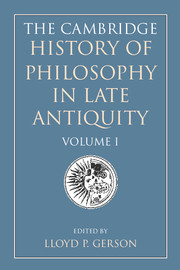Book contents
- Frontmatter
- General introduction
- I Philosophy in the later Roman Empire
- II The first encounter of Judaism and Christianity with ancient Greek philosophy
- III Plotinus and the new Platonism
- IV Philosophy in the age of Constantine
- V The second encounter of Christianity with ancient Greek philosophy
- Introduction to Part V
- 24 Basil of Caesarea
- 25 Gregory of Nyssa
- 26 Gregory of Nazianzus
- 27 Calcidius
- 28 Nemesius of Emesa
- 29 Synesius of Cyrene
- 30 Marius Victorinus
- 31 Augustine
- Map 1 The Byzantine Empire, c. 500
26 - Gregory of Nazianzus
from V - The second encounter of Christianity with ancient Greek philosophy
Published online by Cambridge University Press: 28 May 2011
- Frontmatter
- General introduction
- I Philosophy in the later Roman Empire
- II The first encounter of Judaism and Christianity with ancient Greek philosophy
- III Plotinus and the new Platonism
- IV Philosophy in the age of Constantine
- V The second encounter of Christianity with ancient Greek philosophy
- Introduction to Part V
- 24 Basil of Caesarea
- 25 Gregory of Nyssa
- 26 Gregory of Nazianzus
- 27 Calcidius
- 28 Nemesius of Emesa
- 29 Synesius of Cyrene
- 30 Marius Victorinus
- 31 Augustine
- Map 1 The Byzantine Empire, c. 500
Summary
GREGORY’S PLACE IN HISTORY
Gregory of Nazianzus (329–390), described by some of the Renaissance commentators as the ‘Christian Demosthenes’, is the most well documented of all the early Christian rhetoricians with the exception of Augustine. Like the great African rhetor he leaves his reader copious autobiographical information from which a critical biography can be successfully constructed. It was Gregory, indeed, who introduced the genre of autobiography into Christian letters as a way of making theological inquiry, as well as rhetorically attacking enemies, anticipating Augustine’s efforts along the same lines by a generation. Accordingly, we have from his pen a host of autobiographical letters, poems and orations. He also was the first to model, for Christian use, the genre of the Funeral Encomium; taking Greek precedents and reworking them to new moral and eschatological ends. In his Funeral Orations for several of his family members (Orations 7, 8, 18) he gives us a fascinating picture of an extremely well-placed and wealthy provincial family that straddled the era from Constantine to Theodosius the Great, and was actively involved with the court at several instances, particularly under Julian (whom he knew personally) as well as under Valens, whose state visit to Caesarea Gregory helped orchestrate (alongside Basil the Great), and lastly under Theodosius I, whom he thought rather dim, but who elevated Gregory to high office, as Archbishop of his imperial capital.
Keywords
- Type
- Chapter
- Information
- The Cambridge History of Philosophy in Late Antiquity , pp. 482 - 497Publisher: Cambridge University PressPrint publication year: 2000
- 6
- Cited by

